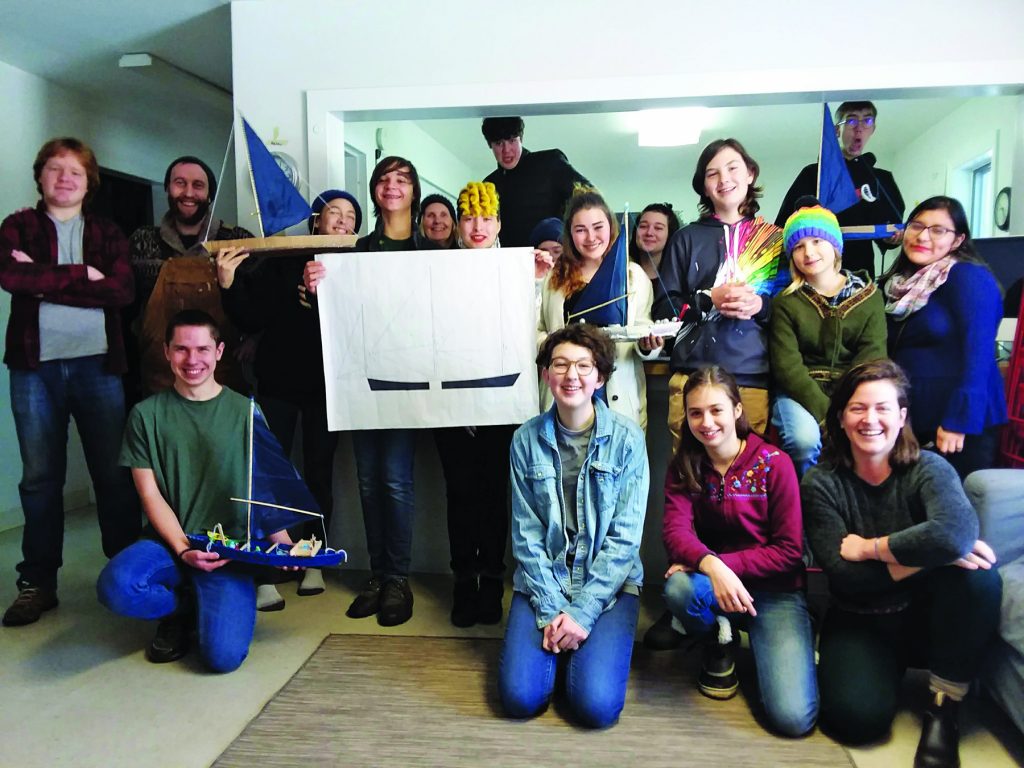
by Chris Wolf, Dean of Students, Springhouse Community School
On a mild Thursday at the end of February, a minivan rolled up to a construction site about midday as the work crew were taking their lunch break. Some adolescents piled out of the van with poster board and a box of supplies. This was Internship-Project Presentation Day for two seventh-graders at Springhouse Community School.
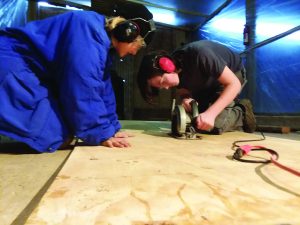 One of these boys presented to the Omnibuild carpenters on the history of the circular saw. The other presented on how a router could be used with a jig to scarph lumber into strong sections; long enough for a mast. These two students had been interning at “The Boat Shop”; helping to build a 22-foot sailboat that the school will take to the Chesapeake Bay on their year-end trip in May.
One of these boys presented to the Omnibuild carpenters on the history of the circular saw. The other presented on how a router could be used with a jig to scarph lumber into strong sections; long enough for a mast. These two students had been interning at “The Boat Shop”; helping to build a 22-foot sailboat that the school will take to the Chesapeake Bay on their year-end trip in May.
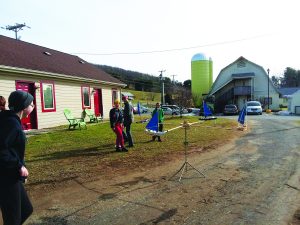 This is what reimagining education looks like in Floyd. Springhouse Community School offers an independent, learner-centered 7th-12th grade program. The mission of the school is to reimagine the purpose and practice of education. This boat-building project started with a conversation between Jenny Finn, Head of School at Springhouse, and David Reece who is an educator, sometimes carpenter, and lifelong lover of all things nautical.
This is what reimagining education looks like in Floyd. Springhouse Community School offers an independent, learner-centered 7th-12th grade program. The mission of the school is to reimagine the purpose and practice of education. This boat-building project started with a conversation between Jenny Finn, Head of School at Springhouse, and David Reece who is an educator, sometimes carpenter, and lifelong lover of all things nautical.
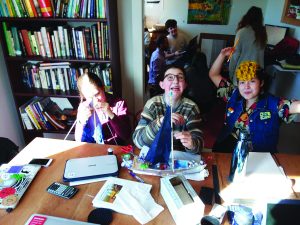 Courses quickly took shape around the effort. Opportunities with the school’s nascent Community Internship Program became apparent, and with generous donations from community sponsors, as well as a successful Kickstarter campaign, the project set sail. In some of the multi-disciplinary courses this year, students at Springhouse are exploring concepts in math and science through the lens of the sailboat. They are also learning about sailing and the nautical world. In classroom explorations, students may build scale models of sailboats while computing the dimensions from plans for the actual boat.
Courses quickly took shape around the effort. Opportunities with the school’s nascent Community Internship Program became apparent, and with generous donations from community sponsors, as well as a successful Kickstarter campaign, the project set sail. In some of the multi-disciplinary courses this year, students at Springhouse are exploring concepts in math and science through the lens of the sailboat. They are also learning about sailing and the nautical world. In classroom explorations, students may build scale models of sailboats while computing the dimensions from plans for the actual boat.
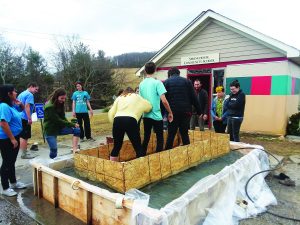 On another day, they may be found weighing ten students at a time in a class-made plywood box by marking the level of submersion and calculating the displacement. Other students might be researching the coastal ecology of the Chesapeake Bay, or learning to calculate distances on a nautical chart. Learning by doing is one of the four core practices at Springhouse.
On another day, they may be found weighing ten students at a time in a class-made plywood box by marking the level of submersion and calculating the displacement. Other students might be researching the coastal ecology of the Chesapeake Bay, or learning to calculate distances on a nautical chart. Learning by doing is one of the four core practices at Springhouse.
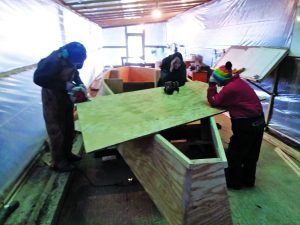 Students can quickly find theoretical concepts relevant, as the ideas take on physical and practical expression. Concepts in physics are not just represented with a formula, they are experienced. Math problems are not just for a worksheet, they are tied to real and tangible projects. Seventh and eighth grade students at Springhouse are out in the community, doing internships once a week. Students in grades nine through twelve intern two days per week. Some intern with places like the National Park Service, Floyd Parks and Recreation, and Slaughter’s Grocery. Others intern at “The Boat Shop.” Springhouse didn’t have a workshop or maker-space, so one was created from and old dairy barn that was offered for the project.
Students can quickly find theoretical concepts relevant, as the ideas take on physical and practical expression. Concepts in physics are not just represented with a formula, they are experienced. Math problems are not just for a worksheet, they are tied to real and tangible projects. Seventh and eighth grade students at Springhouse are out in the community, doing internships once a week. Students in grades nine through twelve intern two days per week. Some intern with places like the National Park Service, Floyd Parks and Recreation, and Slaughter’s Grocery. Others intern at “The Boat Shop.” Springhouse didn’t have a workshop or maker-space, so one was created from and old dairy barn that was offered for the project.
 But it gets pretty cold in Southwest Virginia. To keep warm, the students built a space inside the barn that could be heated with a wood stove; essentially a tunnel of plastic sheeting over light framing. The boat-building is well underway. Every aspect of boat construction from lofting and joinery to sail-making and finish work is being carried out by students who are continually challenged to learn new skills.
But it gets pretty cold in Southwest Virginia. To keep warm, the students built a space inside the barn that could be heated with a wood stove; essentially a tunnel of plastic sheeting over light framing. The boat-building is well underway. Every aspect of boat construction from lofting and joinery to sail-making and finish work is being carried out by students who are continually challenged to learn new skills.
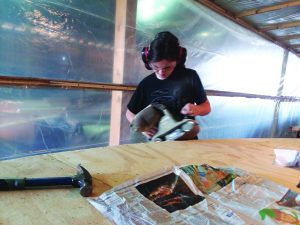 At the end of the day, they come back to the school, usually covered in sawdust, eager to share what new progress has been made. To earn academic credit, every student must complete a project connected to their internship with the support of a mentor. They must then present their work to a relevant audience. That is why the minivan arrived at the construction site that day. Who better to appreciate a presentation on the history of the circular saw than a group of people that use the tool every day?
At the end of the day, they come back to the school, usually covered in sawdust, eager to share what new progress has been made. To earn academic credit, every student must complete a project connected to their internship with the support of a mentor. They must then present their work to a relevant audience. That is why the minivan arrived at the construction site that day. Who better to appreciate a presentation on the history of the circular saw than a group of people that use the tool every day?
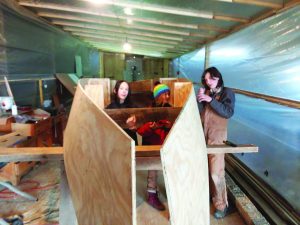 In addition to sharing the history, this student also spoke about his first-hand experiences with the tool. “Before this internship, I had never used a circular saw and it was very scary the first time I used it. It helped that I was spotting one of my friends using it, so I knew what to expect.” The work crew chuckled in an encouraging way as they lent warm attention to the young student.
In addition to sharing the history, this student also spoke about his first-hand experiences with the tool. “Before this internship, I had never used a circular saw and it was very scary the first time I used it. It helped that I was spotting one of my friends using it, so I knew what to expect.” The work crew chuckled in an encouraging way as they lent warm attention to the young student.
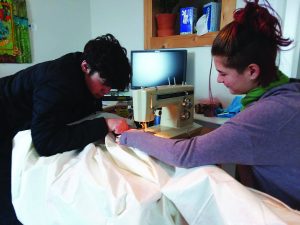 As the presentations wrapped up, the students were clearly relieved. But they were also proud to have presented their work to people outside the immediate school community. Afterward, they debriefed their presentations with the mentor; discussing what went well and what they could improve upon when they present their next projects in the coming trimester. After a tour of the construction site and a glimpse into real-life work in the trades, they headed back to the van; keen to get back to the boat, and real-life work of their own.
As the presentations wrapped up, the students were clearly relieved. But they were also proud to have presented their work to people outside the immediate school community. Afterward, they debriefed their presentations with the mentor; discussing what went well and what they could improve upon when they present their next projects in the coming trimester. After a tour of the construction site and a glimpse into real-life work in the trades, they headed back to the van; keen to get back to the boat, and real-life work of their own.
For more information about Springhouse Community School and to stay up-to-date on enrollment, courses, and events, visit online at www.springhousecommunityschool.org. You can also call (540) 745-4673, or email info@springhousecommunityschool.org.
